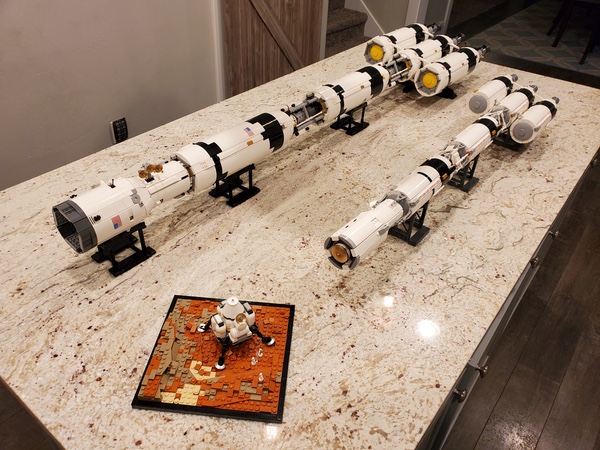Flights to Mars, real and LEGOby Dwayne A. Day
|
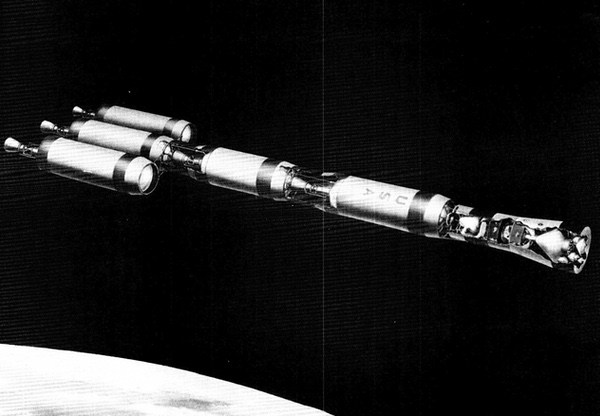 Artwork produced by Boeing in late 1967 for an extensive study of a human Mars mission using NERVA nuclear rocket engines. This mission concept was later refined in 1969 and became iconic, and variations of this Mars mission appeared in space technology books as well as novels throughout the 1970s and into the 1980s. (credit: Boeing) |
Post-Apollo planning and dreaming
Throughout the 1960s, NASA sponsored numerous studies of human missions to Mars. Many in the agency viewed the Apollo program as the first step on the way to bigger things, including Mars, and the agency looked at various ways that a Mars mission could be undertaken, including the possible use of Apollo hardware. The 14-month study that Boeing concluded in January 1968 was, in the words of space historian David Portree in his book Humans to Mars: Fifty Years of Mission Planning, 1950-2000, “the most detailed description of an interplanetary ship ever undertaken.” The spacecraft would use nuclear rockets to propel it to Mars. It would take six uprated Saturn V launches to put the vehicle in orbit. The piloted spacecraft would be 108 feet (33 meters) long, with a 474-foot-long (144-meter) propulsion section. The spacecraft would have five NERVA nuclear rocket engines. The piloted spacecraft would carry six people in a four-deck Mission Module, an Earth Entry Module, and a Mars Excursion Module (MEM) lander shaped like an Apollo spacecraft, although significantly larger. Portree described the overall mission as “Boeing’s behemoth.”
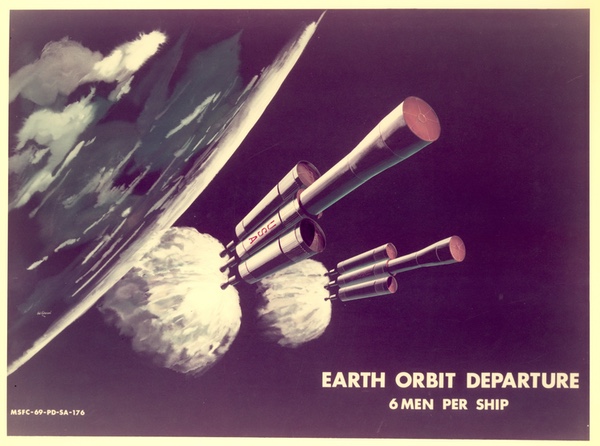 In 1969, NASA revised the Boeing mission concept, making the spacecraft smaller, but launching two of them for redundancy. This artwork was widely circulated in the early 1970s. (credit: NASA) |
By summer 1969, NASA was deeply involved in proposing post-Apollo plans. NASA’s proposal to a Space Task Group established by the Nixon Administration was based upon the Integrated Program Plan, which included a space station, lunar exploration, a space shuttle, and soon, a Mars mission. The Mars spacecraft in the proposal was based upon Boeing’s 1968 study but was not nearly as massive—only half as long. The 1969 proposal only existed in the form of briefing slides, so it is not clear how the designers were able to so drastically reduce the size of the spacecraft. But they made up for it by proposing that the Mars mission consist of two Mars ships instead of only one. They would both be assembled in Earth orbit and serviced by reusable space shuttles, and in the early 1980s for safety they would both depart together for Mars. Their propulsion stages would consist of “Nuclear Shuttles” developed for operation in cislunar space and capable of reuse.
The political winds had shifted against expensive human space exploration long before the summer of 1969 and the Mars mission, which was only supposed to be the capstone at the top of NASA’s ambitious plans, never had a chance for approval. NASA officials soon found themselves scrambling to justify any human spaceflight activity at all, let alone the exquisite program they had envisioned.
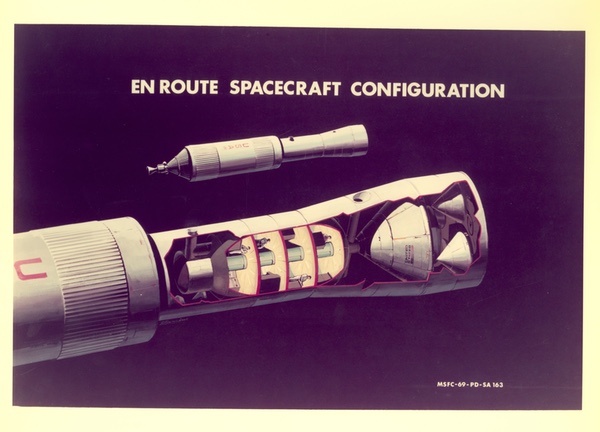 Above: The Mars spacecraft had multiple levels and a Mars Excursion Module (MEM) at the front. This concept appeared in several novels starting in the 1970s, and the MEM design appeared in artwork in books and magazines. Below: The Mars vehicle returns to Earth. (credit: NASA) 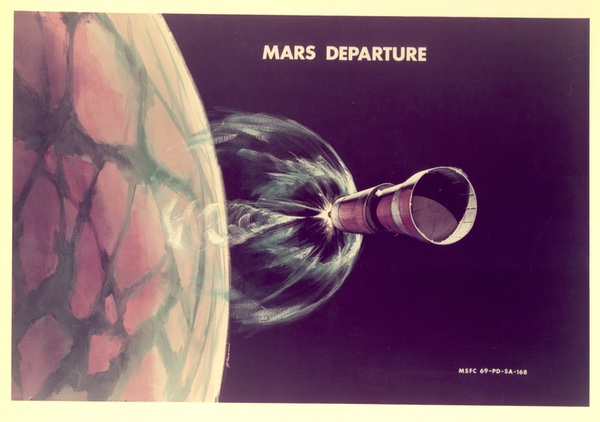 |
But by this time, the Mars spaceship design had gone public. Marshall Space Flight Center artists had produced artwork showing the multiple phases of the Mars mission and that artwork was soon published in many places, such as books about future spaceflight. The Apollo-shaped MEM also became iconic and was also illustrated by numerous artists. Although the public knew that a future Mars mission had not been approved, they could reasonably expect that if it eventually happened, this was what it would look like.
In 1978, Canadian-American science fiction author Gordon Dickson published the novel The Far Call, about a mission to Mars which employed a spacecraft similar to the one outlined in 1969. It also appeared in Allen Drury’s heavy-handed 1971 book The Throne of Saturn. In 1996, Stephen Baxter published Voyage, which also used a similar spacecraft, although an accident involving a nuclear propulsion stage has tragic consequences. (See: “Space alternate history before For All Mankind: Stephen Baxter’s NASA trilogy,” The Space Review, June 8, 2020.)
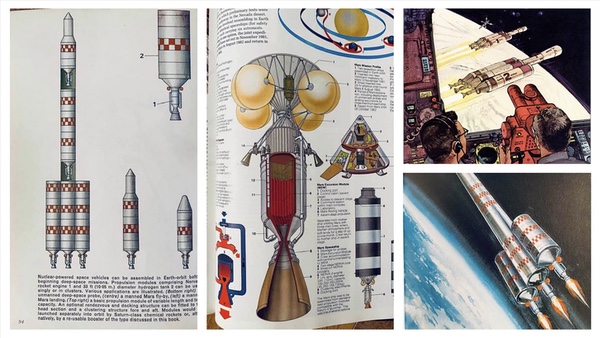 The basic Boeing Mars mission concept appeared in space technology books throughout the 1970s and into the 1980s. It was eventually replaced by a concept produced by the Case for Mars Conferences. (credit: Dwayne Day, images from several books) |
Graphic artists have also been inspired by the design, including a detailed series of illustrations created by an artist who went by the nickname Drell-7. He depicted the revised 1969 mission concept as part of what he dubbed “the Argosy mission.”
 Above: TOver forty years later, artists were still producing images of the late 1960s Mars mission concept. This is by Drell-7 on the art forum DeviantArt. Below: The Mars Excursion Module on Mars by Drell-7 on the art forum DeviantArt. (credit: Drell-7/DeviantArt) 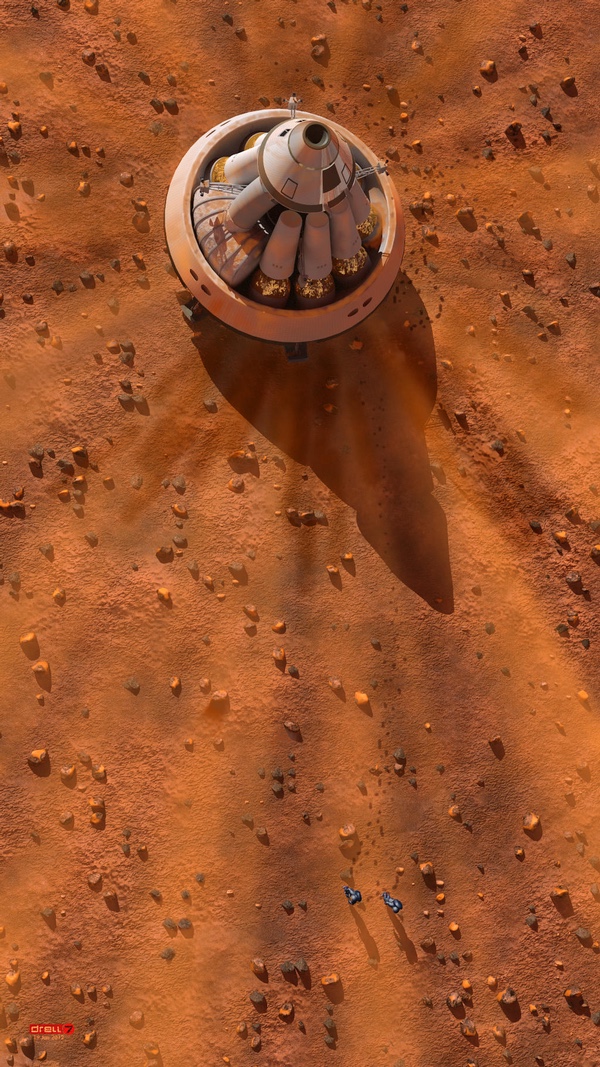 |
To Mars by LEGO
In 2020, Joseph Chambers decided to produce a LEGO model of a Mars spacecraft. His initial design was loosely based upon the 1969 Mars exploration spacecraft. It featured more modules and fuel tanks, and the overall spacecraft was beefier. It looked a lot like what a Hollywood movie would produce as a “realistic” Mars mission—based in NASA engineering and realish physics, but cooler than reality. After I shared with him the report and a bunch of illustrations of the 1968 Boeing design, Chambers decided to re-do his Mars spacecraft and base it on the Boeing design, making it smaller than the LEGO spacecraft he had originally designed, but much closer to the actual spacecraft that Boeing engineers proposed more than 50 years ago.
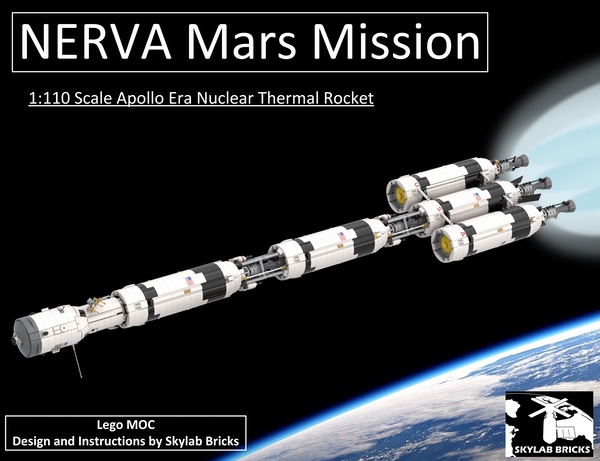 In 2021, Joe Chambers produced a Mars spacecraft from LEGO. He offers detailed instructions, including a parts list, for making your own Mars spacecraft. (credit: Joe Chambers) |
“The program I use for design and rendering, as well as for making the instructions, is a program called Studio.” Chambers explained. “It’s free CAD software created by Brick Link, a LEGO owned site that acts as a storefront for people who want to resell new and used LEGO parts. One of the advantages of Studio is that it is linked directly to Brick Link, so you can check pricing for parts and upload your design directly to wanted lists.”
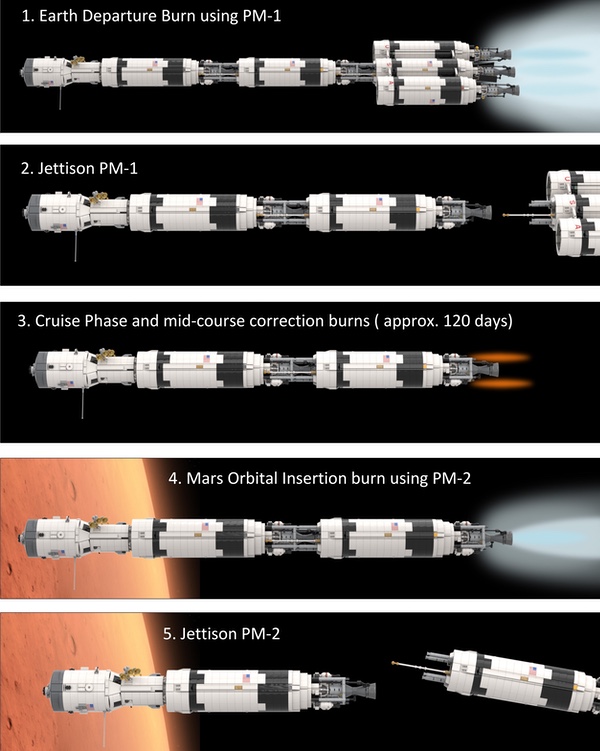 Chambers has also produced a visual timeline showing the mission to Mars. (credit: Joe Chambers) |
Chambers iterated his design. He had previously worked on other space LEGO creations, like an Apollo-era Launch Umbilical Tower and a Delta IV launch vehicle. But those were real. The Mars spacecraft was only a study. “My first iterations were definitely very sci-fi,” Chambers explained, “I certainly did a lot of artistic interpretation. For instance, the original vehicle had a cylindrical interstage between each of the boosters while I opted to use a truss segment to better show off the detail of the engines. On top of that, I made a huge mistake in converting the scale of the design so I ended up with a vehicle that was far smaller than it should have been. This is why I now have two separate designs of the same thing, one at an enormous 1:110 scale, and one at a more affordable 1:155 scale.”
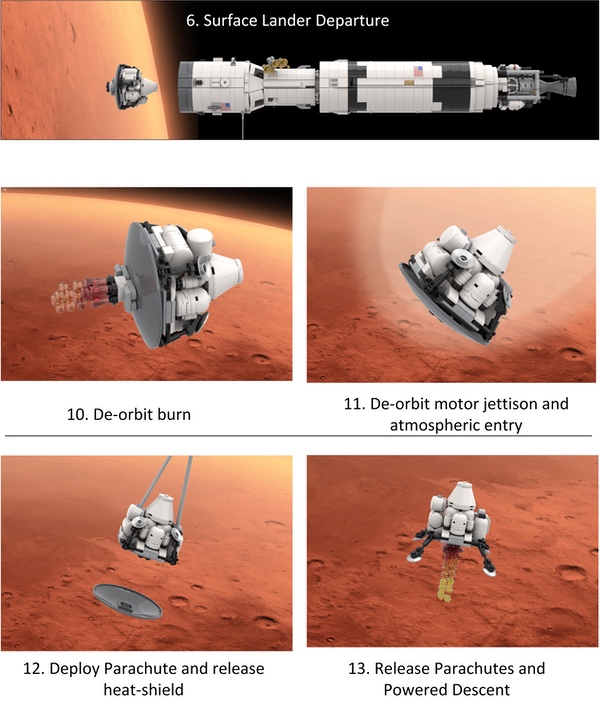 The final landing phase on the red planet. (credit: Joe Chambers) |
“The smaller version comes out to 45 inches (114 centimeters) long with 2,918 pieces, while the larger version, which takes up my whole desk, is 62 inches (157 centimeters) long with 5,614 pieces. Both models use the same Mars surface excursion display and lander. The legs of the lander can fold up and will actually fit inside the front end of the 1:110 scale IMIS spacecraft.”
The late-1960s Mars mission studies included a Mars Excursion Module (or MEM). Only a few, limited studies of the MEM have been released, although there are indications that it was studied in greater detail at the time and those reports have not been made public. More recently, some reentry experts concluded that this MEM design would not have worked—the Apollo shape would not have slowed down enough in Mars’ atmosphere. Chambers has a different Mars lander. He has also started working on a technical write-up with renders of the models for description. “The nerd in me won't let me get away without it.” You can purchase his instructions online, and he also operates the Skylab Bricks page on Facebook.
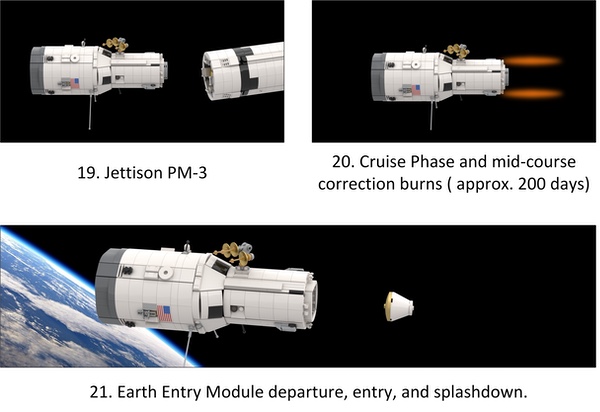 The return phase of the mission. Compare it to the earlier NASA artwork. (credit: Joe Chambers) |
Chambers is also finishing off a series of modified Saturn V launch vehicles, “some of which were studied and designed specifically to put NERVA propulsion modules and parts of the IMIS spacecraft into orbit. This series will be out shortly after the Mars mission instructions and are heavily based on the LEGO Saturn V kit.”
Now all he needs to do is find a place to display it. And who knows? Perhaps soon he will turn his attention to developing the 1980s-era Mars Cycler.
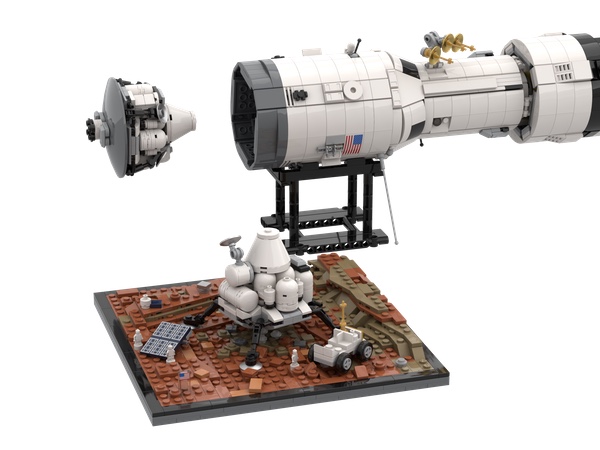 Chambers’ Mars Excursion Module. One version of his LEGO model is over one and a half meters long. (credit: Joe Chambers) |
Note: we are using a new commenting system, which may require you to create a new account.
